仁爱英语七年级下册英语语法知识总结
(完整版)仁爱版英语七年级下全部知识点总结.doc

七年级下英语知识点总结Unit 5 Topic1㈠短语总结1.在学校大门口 at the school gate2.来学校come to school3. 去学校go to school4. 上课have class / have classes5. 步行on foot6.骑自行车ride a bike/ ride bikes/ by bike / on a bike7.坐公交by bus / take a bus8.坐地铁by subway / take the subway / on the subway9.坐飞机by plane/ take the plane / on the plane10.坐小汽车by car / in a car/ take a car/ drive a car11. 坐轮船by ship12. 坐小船by boat13. 坐火车by train / on the train14. 在我们组in our group15.一群学生a group of students16.我们中的三个人 three of us17.在平日 on weekdays18.在周末 on the weekends / at weekends19.起床 get up20.睡觉 go to bed21.早起 get up early22.回家 go home23.到家 get home24.去动物园 go to the zoo25.去公园 go to the park26.看电影 see a movie / film27.看电视 watch TV28.在晚上 in the evening / at night29.帮助父母 help parents30.做某人的家庭作业 do one’s ( my/ her/ his/ your/ their)homework31.在学校 at school32.知道 ,了解 know about / learn about33.校园生活 school life34.一个美国学生 an American student35.在美国 in America / in the U.S.A.36.许多学生 many students/ a lot of students/ lots of students37.很少 very few38.吃午饭 have lunch39.出去吃饭 eat out40.在校期 on school days41.休息一会 have a short rest/ break42.午后 after lunch43.在某人的余 in one’s ( my/ his/ her/ their⋯)free/ spare time44.打球 play basketball45.踢足球 play soccer / football46.琴 play the piano47.吉他 play the guitar48.拉二胡 play erhu49.去游泳 go swimming / go for a swim50.去划船 go boating51.球 a ball game / ball games52.一年四次 four times a year53.听音 listen to music54.read books55.看 read newspapers56.看医生 see a doctor57.去 go to the library58.一周两次 twice a week59.朋友 meet friends60.每天 every day61.在七点半 at half past seven62.一小会 for a little while / for a short time63.晚后 after supper64.吃 have dinner65.吃早 have breakfast㈡重要句型1.I usually come to school by subway.同句 : I usually take the subway to school.划部分提 : How do you usually come to school?似的有:go to school by bike=go to schoolon a bike= ride a bike to school=ride to schoolgo home by bus=go home on a bus=take a bus home2.How do you usually/ often⋯?你通常 /常怎⋯?3.It ’stime for class.=It’s time to have class. =It’s time for having class.4.What about you? =How about you?5.How often ⋯? 率,回答可以用率副: always, usually, often,sometimes, seldom, never, every day ,every +其他名或表示率的短回答表示率的短:次数 +位e.g. : once a day / twice a week / three times a month6.The early bird catches the work. ( ) 笨先7.Work / Study must come first. 工作 / 学必放在第一位!8. Classes begin at eight. =Class begins at eight.提问:What time does the class begin? / What time do the classes begin?㈢重要单词的用法1.look (感官动词 ) 看起来,后面加形容词His mother looks very young.They look very cute.Her dress looks very nice.You look very cool in this coat.2. by 介词by 后面直接加表示交通工具的名词,中间不用任何词修饰,如: by bike by +动词 ing 形式,表示通过某种方式People show love to their mothers by giving cards.You can be a good student by working hard.3.over (形容词 ) School/ Class is over.4.begin现在分词 : beginning 过去式 : beganbegin to do sth , begin doing sthHe begins to write a letter. =He begins writing a letter.如果 begin 本身为分词,只能用begin to do sthHe is beginning to run.5.listen to 听(动作), hear 听见 (结果 )6.always 反义词 never7.本话题涉及的时态为一般现在时,句中常有频率副词或表示频率的短语,如果主语为三单,动词一定要用三单!(四)易错题1.You new watch ______ (look) very nice!2.Here ______(be) some news.3.Oh, come on! It’s time_____ going to school.4.They usually go to school on ________(feet).5.In my class, forty of _______(we) go to school by bike.6.The early bird ______ (catch) the worm.7.Kangkang often _____ (ride) a bike to the park.8.What time _____ (be)school over?9.Work must come ______(once).10.It ’stime ____you to get up.11.We often _____ books in the morning.12.Jill ’s friend like ______(study) in our school.13.Mr. Wang teaches ______(we) English. _____ of us like him.14.How about ______(go) out with me?15.Most students go to school _____ the school bus.16._______ do you go shopping with your mother?A. How soonB. How farC. How oftenD. How much17. What time do you usually get up _____ weekdays?18. He ______ busy, so he has no time to play with us.A. is alwaysB. seldom isC. always isD. often is19.The last class______(finish) at twelve o’clock.20.Let’s go______(boat).21.It’stime to have breakfast. 同(义句 )______________________________________________________.22.Michael often rides a bike to school. 同(义句 )______________________________________________________.23.I always go to work on foot. (对划线部分提问 )______________________________________________________.24.My mother goes shopping twice a week. 对(划线部分提问 )______________________________________________________.25.Mary always reads books in the library. 反(义句 )______________________________________________________.26.He usually does his homework at school.否(定句 )______________________________________________________.27.They often go to school by bus in the morning. 对(划线部分提问 ) ______________________________________________________.28.Jane seldom watches TV on weekdays改.(为一般疑问句 )______________________________________________________.29.He usually has lunch at home. 对(划线部分提问 )______________________________________________________.30.Li Ping often goes to work on foot. (同义句 )______________________________________________________.31.几乎没有学生乘地铁去学校。
仁爱英语七年级下册重点语法知识归纳

七年级下期末考试复习一、名词的数可数名词的复数在名词后加“-s/-es”,不可数名词没有复数重点记忆:可数名词:bus-buses box-boxes knife-knives man-men woman-women snowman-snowmen baby-babies glass-glasses family-families tomato-tomatoes(马铃薯) foot-feet mouse-mice child-children shelf-shelvesactivity-activities country-countries mouse-mice wish-wishes leaf-leaves不可数名词:hair chicken rice bread water milk juice food homework work meat单复数都是同一个词(单复同形):Chinese Japanese people sheep(绵羊)一、冠词元音因素前用“an”,辅音因素前用“a”重点记忆:an apple an English teacher an office worker an American an “eleven”一个十一an eraser an egg an orange an ear an actor an office an order (一个命令) an email(一封邮件)冠词“the”是特指,写作时一般用于第二次出现的人和事物二、数词重点记忆:first second third fifth eighth ninth twelfth fifteenth fortieth三、动词1.动词的单三形式:一般加“-s/-es”, 部分双写最后一个字母,辅音+y结尾,要把“y”变成“i”,再加“es”,具体规则参考课本,下面列举出需要重点记忆的单词:do-does have-has teach-teaches go-goes catch-catches fly-flies try-tries study-studies watch-watchesstudy-studies wish-wishes2.动词的“-ing”形式,一般情况下在动词后加“-ing”,不发音的“e”结尾要去“e”后才加“-ing”,如:have-having live-living come-coming drive-driving make-making ride-riding use-using write-writing change-changing shine-shining prepare-preparing share-sharing arrive-arriving believe-believing 部分需双写最后一个字母后再加“-ing”,如:swim-swimming shop-shopping get-getting sit-sitting run-running3.动词的过去式,一般情况下加“-ed”,辅音加“y”结尾,先把“y”变成“i”再加“-ed”,部分要双写最后一个字母,部分是不规则变化,具体参考课本。
(完整版)(仁爱版)英语七年级下册知识点归纳
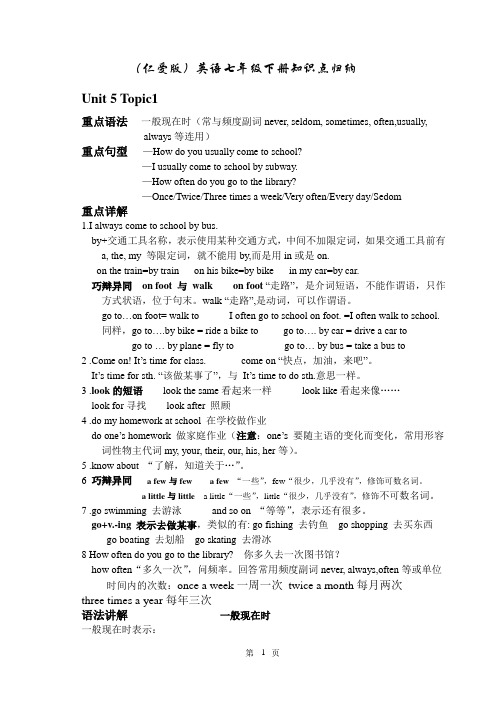
(仁爱版)英语七年级下册知识点归纳Unit 5 Topic1重点语法一般现在时(常与频度副词never, seldom, sometimes, often,usually, always等连用)重点句型—How do you usually come to school?—I usually come to school by subway.—How often do you go to the library?—Once/Twice/Three times a week/Very often/Every day/Sedom重点详解1.I always come to school by bus.by+交通工具名称,表示使用某种交通方式,中间不加限定词,如果交通工具前有a, the, my 等限定词,就不能用by,而是用in或是on.on the train=by train on his bike=by bike in my car=by car.巧辩异同on foot 与walk on foot “走路”,是介词短语,不能作谓语,只作方式状语,位于句末。
walk “走路”,是动词,可以作谓语。
go to…on foot= walk to I often go to school on foot. =I often walk to school.同样,go to….by bike = ride a bike to go to…. by car = drive a car to go to … by plane = fly to go to… by bus = take a bus to2 .Come on! It’s time for class. come on “快点,加油,来吧”。
It’s time for sth. “该做某事了”,与It’s time to do sth.意思一样。
3 .look的短语look the same看起来一样look like看起来像……look for寻找look after 照顾4 .do my homework at school 在学校做作业do one’s homework 做家庭作业(注意:one’s 要随主语的变化而变化,常用形容词性物主代词my, your, their, our, his, her等)。
(完整版)仁爱版七年级英语下册知识点总结
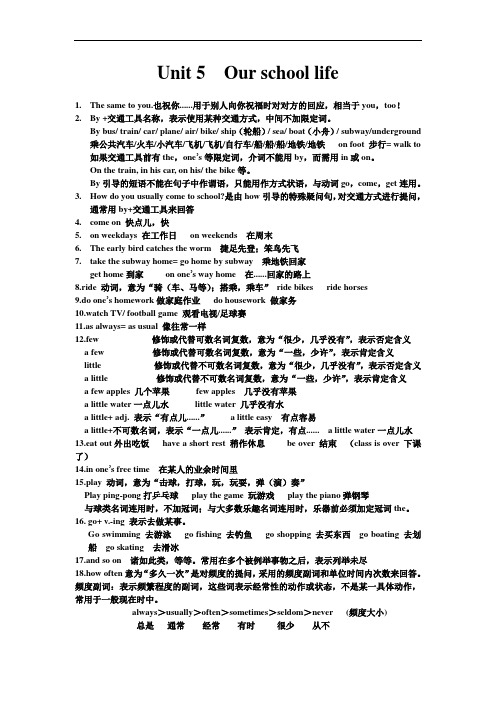
Unit 5 Our school life1.The same to you.也祝你......用于别人向你祝福时对对方的回应,相当于you,too!2.By +交通工具名称,表示使用某种交通方式,中间不加限定词。
By bus/ train/ car/ plane/ air/ bike/ ship(轮船)/ sea/ boat(小舟)/ subway/underground 乘公共汽车/火车/小汽车/飞机/飞机/自行车/船/船/船/地铁/地铁on foot 步行= walk to 如果交通工具前有the,one’s等限定词,介词不能用by,而需用in或on。
On the train, in his car, on his/ the bike等。
By引导的短语不能在句子中作谓语,只能用作方式状语,与动词go,come,get连用。
3.How do you usually come to school?是由how引导的特殊疑问句,对交通方式进行提问,通常用by+交通工具来回答e on 快点儿,快5.on weekdays 在工作日on weekends 在周末6.The early bird catches the worm 捷足先登;笨鸟先飞7.take the subway home= go home by subway 乘地铁回家get home到家on one’s way home 在......回家的路上8.ride 动词,意为“骑(车、马等);搭乘,乘车”ride bikes ride horses9.do one’s homework做家庭作业do housework 做家务10.watch TV/ football game 观看电视/足球赛11.as always= as usual 像往常一样12.few 修饰或代替可数名词复数,意为“很少,几乎没有”,表示否定含义a few 修饰或代替可数名词复数,意为“一些,少许”,表示肯定含义little 修饰或代替不可数名词复数,意为“很少,几乎没有”,表示否定含义a little 修饰或代替不可数名词复数,意为“一些,少许”,表示肯定含义a few apples 几个苹果few apples 几乎没有苹果a little water一点儿水little water 几乎没有水a little+ adj. 表示“有点儿......” a little easy 有点容易a little+不可数名词,表示“一点儿......”表示肯定,有点...... a little water一点儿水13.eat out外出吃饭have a short rest 稍作休息be over 结束(class is over 下课了)14.in one’s free time 在某人的业余时间里15.play 动词,意为“击球,打球,玩,玩耍,弹(演)奏”Play ping-pong打乒乓球play the game 玩游戏play the piano弹钢琴与球类名词连用时,不加冠词;与大多数乐趣名词连用时,乐器前必须加定冠词the。
语法总结仁爱版英语七年级下册

)语法:(1)公式:主语+be(am,is,are)+v-ing+其他,否定:主语+be(am,is,are)+not+v-ing+其他(2)用法:现在或者现阶段正在进行的动作或者状态(3)规则变化:3+:直接+,去e+,双写+ ※特殊变化:lie-lying,die-dying(4)标志词:Look!Listen!now, at the moment(此时此刻)(5)特殊用法:现在进行表将来表示移动的瞬间动词的现在进行时可以表示将来含义:come, go, fly, move, leave, die等e.g:She is leaving for Shanghai.(1)公式:主语+v-ed(过去式)+其他,否定要借助动词did:主语+didn't+v-原+其他主语+was/were+其他,否定直接加not:主语+was/were+not+其他(2)用法:过去的动作或者状态(3)规则变化:4+(+ed):直接+,去e+,双写+,变y+(4)标志词:①yesterday②ago③last④过去时间短语※in the 1960s(世纪+1)译为二十世纪六十年代3.there be句型(有)(1)there be+某人/某物+方位介词+地点否定:there be+not+某人/某物+方位介词+地点疑问:Be+there+某人/某物+方位介词+地点?特殊疑问:What is 方位介词+地点?(2)句型:there be++方位介词+地点某处有某人/某物正在做某事there be+某人/某物+方位介词+地点某处有某人/某物被...e.g.:There are many old people living in our community. 有很多老人住在我们小区。
e.g.: There are many trees planted in our school.有很多树种在我们学校。
(3)就近原则:there be+某人/某物(主语)+方位介词+地点be动词的选择跟随主语走,多个主语时,根据离be动词近的主语决定。
仁爱版英语七年级下册重要知识点和语法点归纳总结
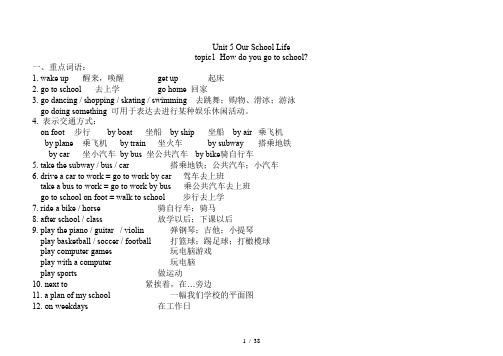
Unit 5 Our School Lifetopic1 How do you go to school?一、重点词语:1. wake up 醒来,唤醒get up 起床2. go to school 去上学go home 回家3. go dancing / shopping / skating / swimming 去跳舞;购物、滑冰;游泳go doing something 可用于表达去进行某种娱乐休闲活动。
4. 表示交通方式:on foot 步行by boat 坐船by ship 坐船by air 乘飞机by plane 乘飞机by train 坐火车by subway 搭乘地铁by car 坐小汽车by bus 坐公共汽车by bike 骑自行车5. take the subway / bus / car 搭乘地铁;公共汽车;小汽车6. drive a car to work = go to work by car 驾车去上班take a bus to work = go to work by bus 乘公共汽车去上班go to school on foot = walk to school 步行去上学7. ride a bike / horse 骑自行车;骑马8. after school / class 放学以后;下课以后9. play the piano / guitar / violin 弹钢琴;吉他;小提琴play basketball / soccer / football 打篮球;踢足球;打橄榄球play computer games 玩电脑游戏play with a computer 玩电脑play sports 做运动10. next to 紧挨着,在…旁边11. a plan of my school 一幅我们学校的平面图12. on weekdays 在工作日at weekends 在周末13. have breakfast / lunch / supper / dinner / meals吃早餐;中餐;晚餐;正餐;一日三餐have classes / lessons / a meeting 上课;上课;开会14. watch TV / movies / games / the animals 看电视;电影;比赛;动物read novels / newspapers / books 看小说;报纸;书15. wash one’s face/ clothes 洗脸;衣服16. 反义词:up – down, early – late 近义词:quickly – fastget up early 早起be late for 迟到17. the first / second / third / fourth day 第一;二;三;四天18. clean the house 打扫房子19. 表示建筑物(尤其学校建筑物):on the playground 在操场at school / home / table 在学校;家里;桌旁in a computer room / teachers’ office / classr oom building / gym / library / lab / canteen在电脑室;教师办公室;教学楼;体操馆;图书馆;实验室;食堂20. around six o’clock = at about six o’clock大约在六点21. 频率副词:never, seldom, sometimes, often, usually, always二、重点句型:1. It’s time to get up.该起床的时候了。
仁爱英语七年级下册语言点、语法归纳

仁爱英语七年级下册语言点、语法归纳仁爱英语七年级下册的语言点、语法归纳如下:1. 动词的一般现在时- 用于表示经常性、习惯性的动作或存在;- 句子结构:主语 + 动词原形(第三人称单数加-s);- 例句:She goes to school every day.2. 形容词的比较级和最高级- 用于比较两个人或物的特征;- 变化形式:比较级(加-er)和最高级(加-est或在前面加most);- 例句:She is taller than her sister.3. 一般过去时- 用于表示过去发生的动作或存在;- 句子结构:主语 + 动词过去式;- 例句:We visited the Great Wall last week.4. there be句型- 用于描述存在或发生在某个地方的人或事物;- 句子结构:There + be动词 + 名词;- 例句:There is a cat in the room.5. 情态动词can和must- can表示能力、允许或请求等;- must表示必须或推测等;- 例句:You can play the piano.- 例句:You must finish your homework.6. 简单陈述句的一般疑问句- 用于询问是否是事实或陈述的正确性;- 句子结构:助动词提到句首 + 主语 + 动词;- 例句:Are you a teacher?7. 时间状语从句- 用于引导表示时间的从句;- 句子结构:时间状语 + 主句;- 例句:When I was young, I liked to play football.8. 动词的-ing形式- 表示正在进行的动作或状态;- 句子结构:主语 + be动词 + 动词-ing;- 例句:She is running in the park.9. 介词的使用10. 物主代词的使用11. 数词的使用12. 够则句的使用13. 句子的省略14. 名词的复数形式及其变化规则15. 以人称代词作为主语的句子16. 特殊疑问句17. 时态的转换和语态的改变18. 定语从句19. 情态动词的否定形式20. 短语动词的使用和变化等等。
七年级下册仁爱版英语语法归纳

七年级下册仁爱版英语语法归纳1. 一般现在时态 (Simple Present Tense)- 用于对经常性或习惯性事件的陈述,或表示客观事实。
- 结构:主语 + 动词原形 (+ 其他补充信息)- 例句:I play tennis every Saturday. (我每个星期六都打网球)2. 一般过去时态 (Simple Past Tense)- 用于过去发生的动作或情况的陈述。
- 结构:主语 + 动词过去式 (+ 其他补充信息)- 例句:She watched a movie last night. (她昨晚看了一部电影)3. 一般将来时态 (Simple Future Tense)- 用于对将来的动作或情况的陈述。
可以通过 will 或 be goingto 表示。
- 结构:主语 + will/shall + 动词原形 (或主语 + be going to + 动词原形) (+ 其他补充信息)- 例句:They will go on a trip next month. (他们下个月将去旅行)4. 现在进行时态 (Present Continuous Tense)- 用于对正在进行的动作或情况的陈述。
- 结构:主语 + be动词 (am/is/are) + 动词的现在分词 (+ 其他补充信息)- 例句:She is studying in the library now. (她现在正在图书馆学习)5. 过去进行时态 (Past Continuous Tense)- 用于过去某个时间段内正在进行的动作或情况的陈述。
- 结构:主语 + was/were + 动词的现在分词 (+ 其他补充信息) - 例句:We were playing soccer all afternoon yesterday. (昨天下午我们一直在踢足球)6. 现在完成时态 (Present Perfect Tense)- 用于表示过去发生的动作对现在造成的影响,或挥之不去的经历。
七年级下册英语语法重点仁爱版

⼀. 词汇 ⑴单词 1. 介词:in, on, under, behind, near, at, of 1). in表⽰;中;在内。
例如: in our class 在我们班上 in my bag 在我的书包⾥ in the desk 在桌⼦⾥ in the classroom 在教室⾥ 2). on 表⽰;在;;上;。
例如: on the wall 在墙上 on the desk 在桌⼦上 on the blackboard 在⿊板上 3). under表⽰;在;;下;。
例如: under the tree 在树下 under the chair 在椅⼦下 under the bed 在床下 4). behind表⽰;在;;后⾯;。
例如: behind the door 在门后 behind the tree 在树后 5). near表⽰;在;;附近;。
例如: near the teachers desk 在讲桌附近 near the bed 在床附近 6). at表⽰;在;;处;。
例如: at school 在学校 at home 在家 at the door 在门⼝ 7). of 表⽰的;。
例如: a picture of our classroom 我们教室的⼀幅画 a map of China ⼀张中国地图 nbsp; 2. 冠词 a / an / the: 冠词⼀般位于所限定的名词前,⽤来署名名词所指的⼈或事物。
冠词有不定冠词和定冠词两种。
不定冠词有两个形式,即a和an。
a⽤在以辅⾳⾳素开头的词前,如a book; an⽤在以元⾳⾳素开头的字母前,如an apple. a或an与可数名词单数连⽤,泛指某类⼈或某物中的⼀个。
This is a cat. 这是⼀只猫。
It#39;s an English book. 这是⼀本英语书。
His father is a worker. 他的爸爸是个⼯⼈。
七年级仁爱版英语语法

七年级仁爱版英语语法以下是七年级仁爱版英语语法总结:
一、名词
1. 名词的数
2. 名词的格
二、代词
1. 人称代词
2. 物主代词
3. 反身代词
4. 指示代词
5. 不定代词
三、形容词和副词
1. 形容词
2. 副词
3. 形容词和副词的比较级和最高级
四、介词
1. 常用介词的用法
2. 介词短语
五、数词
1. 基数词和序数词的构成和用法
2. 分数的表达法
3. 小数的表达法
4. 年、月、日的表达法
5. 时间表达法
六、动词
1. 动词的基本形式和变化规则
2. 动词的时态(现在时、过去时、将来时)
3. 情态动词(can, may, must等)的用法
4. 非谓语动词(不定式、动名词)的用法
5. 动词短语和固定搭配
6. 被动语态的构成和用法
7. 虚拟语气的用法(if条件句、wish宾语从句等)
8. 动词不定式的用法(作主语、宾语、定语等)
9. 动名词的用法(作主语、宾语、定语等)
10. 现在分词的用法(作定语、状语等)
11. 过去分词的用法(作定语、状语等)
12. 常见动词辨析(如:go, come, arrive等)
13. 常见动词短语和固定搭配(如:make up, break down等)
14. 常见动词辨析(如:look, see, watch等)。
仁爱版七年级下册英语复习知识点
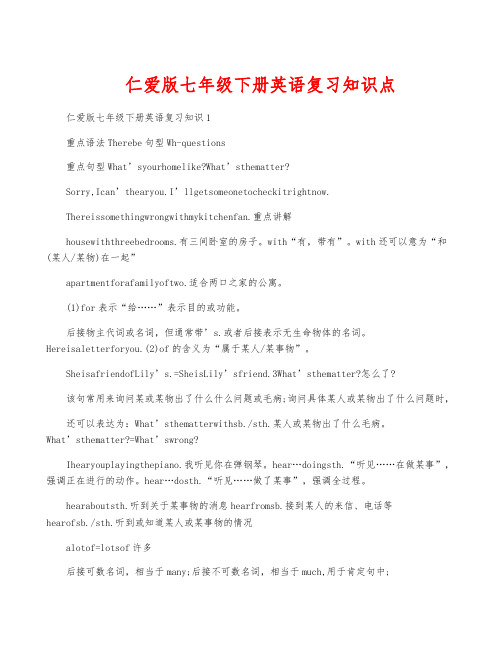
仁爱版七年级下册英语复习知识点仁爱版七年级下册英语复习知识1重点语法Therebe句型Wh-questions重点句型What’syourhomelike?What’sthematter?Sorry,Ican’thearyou.I’llgetsomeonetocheckitrightnow.Thereissomethingwrongwithmykitchenfan.重点讲解housewiththreebedrooms.有三间卧室的房子。
with“有,带有”。
with还可以意为“和(某人/某物)在一起”apartmentforafamilyoftwo.适合两口之家的公寓。
(1)for表示“给……”表示目的或功能。
后接物主代词或名词,但通常带’s.或者后接表示无生命物体的名词。
Hereisaletterforyou.(2)of的含义为“属于某人/某事物”。
SheisafriendofLily’s.=SheisLily’sfriend.3What’sthematter?怎么了?该句常用来询问某或某物出了什么什么问题或毛病;询问具体某人或某物出了什么问题时,还可以表达为:What’sthematterwithsb./sth.某人或某物出了什么毛病。
What’sthematter?=What’swrong?Ihearyouplayingthepiano.我听见你在弹钢琴。
hear…doingsth.“听见……在做某事”,强调正在进行的动作。
hear…dosth.“听见……做了某事”,强调全过程。
hearaboutsth.听到关于某事物的消息hearfromsb.接到某人的来信、电话等hearofsb./sth.听到或知道某人或某事物的情况alotof=lotsof许多后接可数名词,相当于many;后接不可数名词,相当于much,用于肯定句中;但是注意:如果是否定句,则常用many或much.befarfrom…离……远(抽象距离)be…awayfrom…离……远(具体距离)Myschoolisnotfarfromthebookstore.Theseais2milesawayfromthehotel.7Thereissomethi ngwrongwithsb./sth.某人或某物出问题/有毛病了。
(完整版)仁爱英语七年级下册重要知识点和语法点归纳,推荐文档

Unit 5 Our School Lifetopic1How do you go to school?一、重点词语:1. wake up醒来,唤醒get up起床2. go to school去上学go home 回家3. go dancing / shopping / skating / swimming去跳舞;购物、滑冰;游泳go doing something可用于表达去进行某种娱乐休闲活动。
4.表示交通方式:on foot步行by boat坐船by ship坐船by air乘飞机by plane乘飞机by train坐火车by subway搭乘地铁by car坐小汽车by bus坐公共汽车by bike骑自行车5. take the subway / bus / car搭乘地铁;公共汽车;小汽车6. drive a car to work = go to work by car驾车去上班take a bus to work = go to work by bus乘公共汽车去上班go to school on foot = walk to school步行去上学7. ride a bike / horse骑自行车;骑马8. after school / class放学以后;下课以后9. play the piano / guitar / violin弹钢琴;吉他;小提琴play basketball / soccer / football打篮球;踢足球;打橄榄球play computer games玩电脑游戏play with a computer玩电脑play sports做运动10. next to紧挨着,在⋯旁边11. a plan of my school一幅我们学校的平面图12. on weekdays在工作日at weekends在周末13. have breakfast / lunch / supper / dinner / meals吃早餐;中餐;晚餐;正餐;一日三餐have classes / lessons / a meeting上课;上课;开会14. watch TV / movies / games / the animals看电视;电影;比赛;动物read novels / newspapers / books看小说;报纸;书15. wash one ’s face / clothes洗脸;衣服16. 反义词: up – down, early– late近义词:quickly– fastget up early早起be late for迟到17. the first / second / third / fourth day第一;二;三;四天18. clean the house打扫房子19.表示建筑物(尤其学校建筑物):on the playground在操场at school / home / table在学校;家里;桌旁in a computer room / teachers’ office / classroom building / gym / library / lab / canteen在电脑室;教师办公室;教学楼;体操馆;图书馆;实验室;食堂20. around six o’clock = at about six o’clock大约在六点21. 频率副词: never, seldom, sometimes, often, usually, always二、重点句型:1.It’s time to get up.该起床的时候了。
仁爱英语七年级下册Unit 7 英语重点短语句子语法梳理
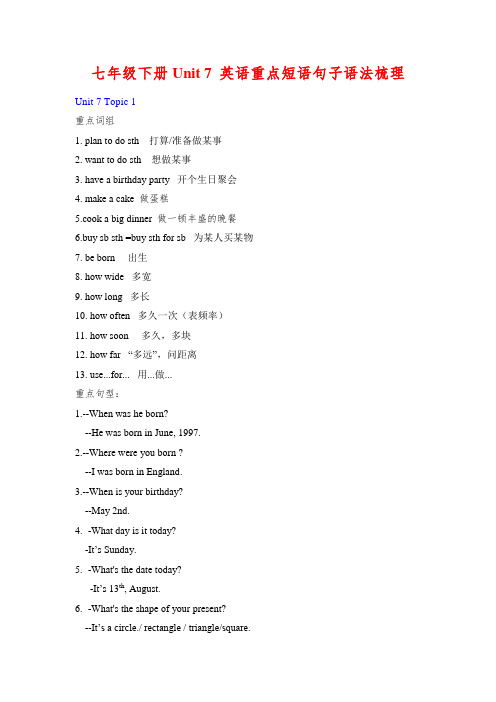
七年级下册Unit 7 英语重点短语句子语法梳理Unit 7 Topic 1重点词组1. plan to do sth 打算/准备做某事2. want to do sth 想做某事3. have a birthday party 开个生日聚会4. make a cake 做蛋糕5.cook a big dinner 做一顿丰盛的晚餐6.buy sb sth =buy sth for sb 为某人买某物7. be born 出生8. how wide 多宽9. how long 多长10. how often 多久一次(表频率)11. how soon 多久,多块12. how far “多远”,问距离13. use...for... 用...做...重点句型:1.--When was he born?--He was born in June, 1997.2.--Where were you born ?--I was born in England.3.--When is your birthday?--May 2nd.4.-What day is it today?-It’s Sunday.5.-What's the date today?-It’s 13th, August.6.-What's the shape of your present?--It’s a circle./ rectangle / triangle/square.7.--How long/wide is it?--It’s...long/wide.8. --What do we use it for?--We use it to study English.9.--What’s it like ?--It’s like a star.重点语法1 英语中日期可以有两种表达法:(1)月日,年。
May 1st, 2008(2)日月,年。
七年级英语下册重要知识点和语法点归纳仁爱版
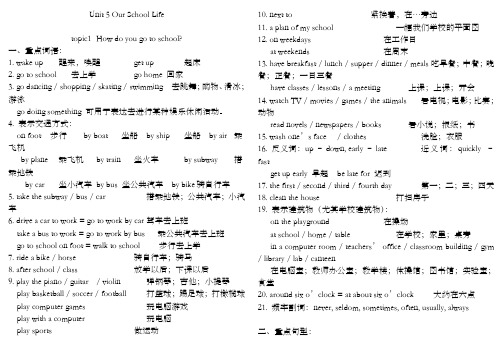
Unit 5 Our School Lifetopic1 H ow do you go to school?一、重点词语:1. wake up 醒来,唤醒get up 起床2. go to school 去上学go home 回家3. go dancing / shopping / skating / swimming 去跳舞;购物、滑冰;游泳go doing something 可用于表达去进行某种娱乐休闲活动。
4. 表示交通方式:on foot 步行by boat 坐船by ship 坐船by air 乘飞机by plane 乘飞机by train 坐火车by subway 搭乘地铁by car 坐小汽车by bus 坐公共汽车by bike 骑自行车5. take the subway / bus / car 搭乘地铁;公共汽车;小汽车6. drive a car to work = go to work by car 驾车去上班take a bus to work = go to work by bus 乘公共汽车去上班go to school on foot = walk to school 步行去上学7. ride a bike / horse 骑自行车;骑马8. after school / class 放学以后;下课以后9. play the piano / guitar / violin 弹钢琴;吉他;小提琴play basketball / soccer / football 打篮球;踢足球;打橄榄球play computer games 玩电脑游戏play with a computer 玩电脑play sports 做运动10. next to 紧挨着,在…旁边11. a plan of my school 一幅我们学校的平面图12. on weekdays 在工作日at weekends 在周末13. have breakfast / lunch / supper / dinner / meals吃早餐;中餐;晚餐;正餐;一日三餐have classes / lessons / a meeting 上课;上课;开会14. watch TV / movies / games / the animals 看电视;电影;比赛;动物read novels / newspapers / books 看小说;报纸;书15. wash one’s face/ clothes 洗脸;衣服16. 反义词:up – down, early – late 近义词:quickly –fastget up early 早起be late for 迟到17. the first / second / third / fourth day 第一;二;三;四天18. clean the house 打扫房子19. 表示建筑物(尤其学校建筑物):on the playground 在操场at school / home / table 在学校;家里;桌旁in a computer room / teachers’ office / classroom b uilding / gym / library / lab / canteen在电脑室;教师办公室;教学楼;体操馆;图书馆;实验室;食堂20. around six o’clock = at about six o’clock大约在六点21. 频率副词:never, seldom, sometimes, often, usually, always二、重点句型:1. It’s time to get up.该起床的时候了。
仁爱英语七年级下短语知识点总结
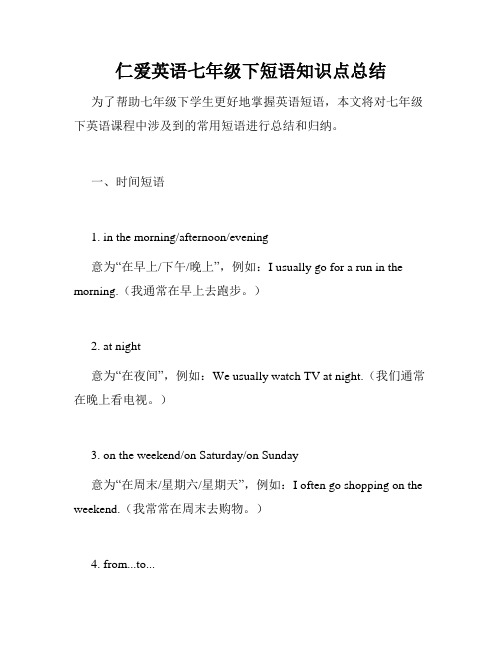
仁爱英语七年级下短语知识点总结为了帮助七年级下学生更好地掌握英语短语,本文将对七年级下英语课程中涉及到的常用短语进行总结和归纳。
一、时间短语1. in the morning/afternoon/evening意为“在早上/下午/晚上”,例如:I usually go for a run in the morning.(我通常在早上去跑步。
)2. at night意为“在夜间”,例如:We usually watch TV at night.(我们通常在晚上看电视。
)3. on the weekend/on Saturday/on Sunday意为“在周末/星期六/星期天”,例如:I often go shopping on the weekend.(我常常在周末去购物。
)4. from...to...意为“从......到......”,例如:I study from Monday to Friday.(我从周一到周五学习。
)二、地点短语1. at home/at school/at the park意为“在家/在学校/在公园”,例如:I like to play with my dog at home.(我在家里喜欢和我的狗玩。
)2. in the city/in the country/in the mountains意为“在城市里/在农村里/在山里”,例如:We live in the city.(我们住在城市里。
)3. on the street/on the road/on the sidewalk意为“在街上/在路上/在人行道上”,例如:I like to walk on the sidewalk.(我喜欢在人行道上散步。
)4. by the seaside/by the lake/by the river意为“在海边/在湖边/在河边”,例如:We had a picnic by the river.(我们在河边野餐。
仁爱版英语七年级下册单元语法
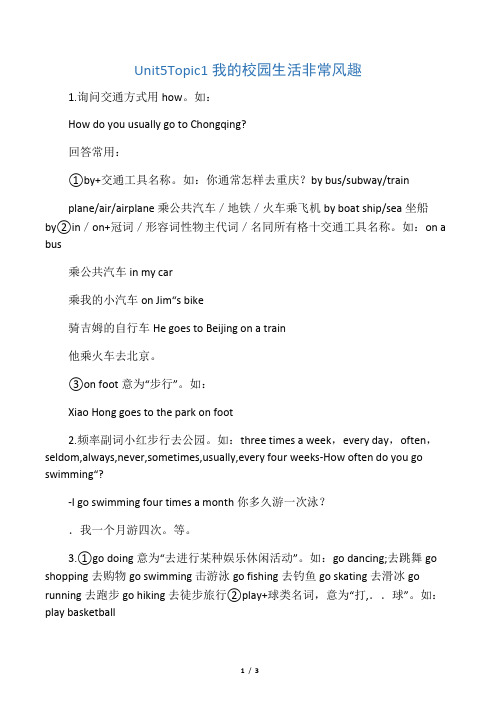
Unit5Topic1我的校园生活非常风趣1.询问交通方式用how。
如:How do you usually go to Chongqing?回答常用:①by+交通工具名称。
如:你通常怎样去重庆?by bus/subway/trainplane/air/airplane乘公共汽车/地铁/火车乘飞机by boat ship/sea坐船by②in/on+冠词/形容词性物主代词/名同所有格十交通工具名称。
如:on a bus乘公共汽车in my car乘我的小汽车on Jim“s bike骑吉姆的自行车He goes to Beijing on a train他乘火车去北京。
③on foot意为“步行”。
如:Xiao Hong goes to the park on foot2.频率副词小红步行去公园。
如:three times a week,every day,often,seldom,always,never,sometimes,usually,every four weeks-How often do you go swimming“?-I go swimming four times a month你多久游一次泳?.我一个月游四次。
等。
3.①go doing意为“去进行某种娱乐休闲活动”。
如:go dancing;去跳舞go shopping去购物go swimming击游泳go fishing去钓鱼go skating去滑冰go running去跑步go hiking去徒步旅行②play+球类名词,意为“打,..球”。
如:play basketball球打篮球play soccer/football踢足球play volleyball打排③play +the+乐器,意为“弹奏某种乐器”。
如:play the guitar4.大凡现在时弹吉他play the piano弹钢琴1.现在进行时⑴现在进行时表示正在发生或进行的动作,常与now, at the moment,look,listen等词语或者短语连用。
仁爱版七年级下册英语重点知识点总结(短语、句型、语法)
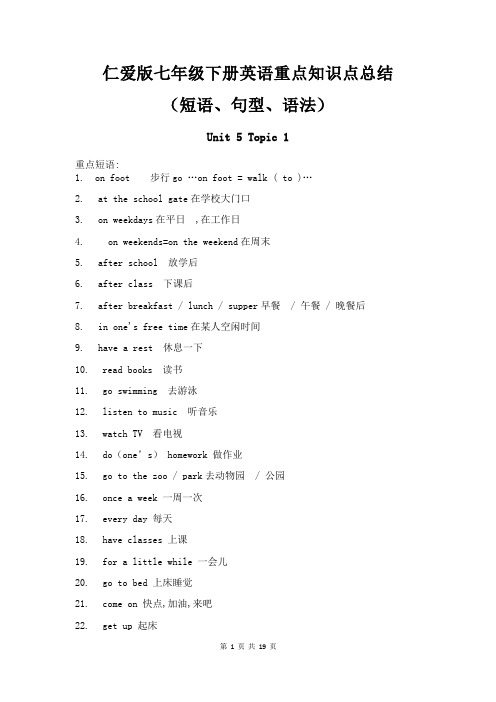
仁爱版七年级下册英语重点知识点总结(短语、句型、语法)Unit 5 Topic 1重点短语:1. on foot 步行go …on foot = walk ( to )…2.at the school gate在学校大门口3.on weekdays在平日,在工作日4.on weekends=on the weekend在周末5.after school 放学后6.after class 下课后7.after breakfast / lunch / supper早餐/ 午餐 / 晚餐后8.in one's free time在某人空闲时间9.have a rest 休息一下10.read books 读书11.go swimming 去游泳12.listen to music 听音乐13.watch TV 看电视14.do(one’s) homework 做作业15.go to the zoo / park去动物园/ 公园16.once a week 一周一次17.every day 每天18.have classes 上课19.for a little while 一会儿20.go to bed 上床睡觉e on 快点,加油,来吧22.get up 起床23.talk with / to s b.与某人谈话24.at school 在学校、在上课25.go to school 去上学26. and so on ……等等重点句型:1. --Happy New Year! --The same to you.2.--Your new bike looks very nice. --Thank you3.--How do you usually come to school? --I usually come to school by subway.4.--How often do you go to the library? --Once/Twice/Three timesa week/Very often/Every day/Seldom5.The early bird catches the worm.(谚语) 笨鸟先飞6.Work / Study must come first.工作/ 学习必须放在第一位!7.Classes begin at eight.=Class begins at eight.8.What time does the class begin?What time do the classes begin?9.We have no more time.我们没有更多的时间了。
仁爱版英语七年级下册知识点复习归纳(完整版)

仁爱版英语七年级下册知识点归纳英语七年级下册知识点归纳Unit 5 Topic1重点语法一般现在时(常与频度副词never, seldom, sometimes, often ,usually, always等连用)重点句型—How do you usually come to school?—I usually come to school by subway.—How often do you go to the library?—Once/Twice/Three times a week/Very often/Every day/Seldom重点详解1I always come to school by bus.by+交通工具名称,表示使用某种交通方式,中间不加限定词,如果交通工具前有a, the, my 等限定词,就不能用by,而是用in或是on.on the train=by train on his bike=by bike in my car=by car.巧辩异同on foot 与walk on foot “走路”,是介词短语,不能作谓语,只作方式状语,位于句末。
walk “走路”,是动词,可以作谓语。
go to…on foot= walk toI often go to school on foot. =I often walk to school.同样,go to….by bike = ride a bike togo to…. by car = drive a car togo to … by plane = fly togo to… by bus = take a bus to2 Come on! It’s time for class. come on “快点,加油,来吧”。
It’s time for sth. “该做某事了”,与 It’s time to do sth.意思一样。
- 1、下载文档前请自行甄别文档内容的完整性,平台不提供额外的编辑、内容补充、找答案等附加服务。
- 2、"仅部分预览"的文档,不可在线预览部分如存在完整性等问题,可反馈申请退款(可完整预览的文档不适用该条件!)。
- 3、如文档侵犯您的权益,请联系客服反馈,我们会尽快为您处理(人工客服工作时间:9:00-18:30)。
七年级下册英语语法一、there be1. there be句型(一)(1)句型结构为:there be(is/are)+某物/某人+地点/时间(介词短语),意为“某处/某地有某人或某物”,表示存在的一种状态,句中be动词的选择由其后面的名词确定.有两种句式:①There is +单数名词/不可数名词+介词短语。
②There are +名词复数形式+介词短语。
③be动词后面的名词如果是由and连接的几个名词时.be动词应遵循就近原则,即与邻近名词的数保持一致。
(2)there be结构的否定句直接在be动词后面加not。
(3)there be结构的疑问形式直接把be动词提前,句末加问号。
肯定回答:Yes,there is/are.否定回答:No,there isn't/aren't .-Are there any books about Chinese history 有关于中国历史的书吗are./No,there aren't. 是的,有。
/不,没有。
-Is there a computer in your study 你的书房有电脑吗-Yes,there is,/No,there isn't. 是的,有。
/不,没有。
2. there be句型(二)(1)针对there be结构的名词提问,常常用what's+地点状语,名词无论是单数形式还是复数形式,be动词都用is,且常省略there。
如:There is a desk in the room. (对画线部分提问)房间里有张桌子。
—— What's in the room 房间里面有什么There are many students in the classroom.(对画线部分提问)教室里有许多学生。
——教室里面有什么(2)针对there be结构中名词的数量提问,用how many或how much提问,后面要紧跟这个名词 .如:There' s a coat on the bed(对画线部分提问)在床上有一件衣服。
——How many coats are there on the bed 在床上有多少件衣服There' re some meat in the bowl(对画线部分提)在碗里有一些肉。
——在碗里有多少肉3. there be句型(三)there be与have(has)的用法区别:there be句型表示“某处/某时有某物或某人”,强调的是一种客观存在,但have表示“某人或某物有……”,强调的是拥有或占有,即某物或某人与主语是所属关系,但有时它们也可以相互转换。
二、时态1. 一般现在时(常与频度副词never,seldom,sometimes,often,usually等连用)一般现在时表示:(1)现在所处的状态。
Janeisatschool.(2)经常或习惯性的动作。
Ioftengotoschoolbybus.(3)主语具备的性格和能力。
Helikesplayingfootball.(4)客观真理。
Theearthgoesroundthesun.常用的时间状语:often,always,usually,sometimes,everyday等等。
行为动词的一般现在时,助动词是do/don’t和does/doesn’t.当主语是第一、二人称和所有复数形式时,行为动词用原形。
肯定式:Igotoschoolonfoot.否定式:Idon’tgotoschoolonfoot.疑问式:Doyougotoschoolonfoot —Yes,Ido.—No,Idon’t.当主语是第三人称单数时,动词用第三人称单数形式,在词尾加-s或-es。
肯定式:Hegoestoworkbybus.否定式:Hedoesn’tgotoworkbybus.疑问式:Doeshegotoworkbybus—Yes,hedoes.—No,hedoesn’t.重点句型—Howdoyouusuallycometoschool—Iusuallycometoschoolbysubway.—Howoftendoyougotothelibrary—Once/Twice/Threetimesaweek/Veryoften/E veryday/Selgoto…onfoot=walkto Ioftengotoschoolonfoot.=Ioftenwalktoschool.goto…bybike=rideabiketo...goto…bycar=driveacarto...goto…byplane=flyto...goto…bybus=takeabusto...2. 现在进行时⑴现在进行时表示正在发生或进行的动作,常与now, at the moment, look, listen 等词语或者短语连用。
⑵结构:主语+be(is,am,are)+现在分词。
如:Mary is having lunch with her parents now. 玛丽正和她的父母一起吃午餐。
They are doing their homework at home. 他们正在家里做家庭作业。
现在进行时态的肯定、否定和疑问式肯定式:Iamrunning. Youarerunning. He/Sheisrunning.否定式:I’ m notrunning.Youare n’ t running.He/Sheis n’ t running.一般疑问句及回答:—Areyourunning—Yes,Iam./—No,Iamnot.—Ishe/sherunning—Yes,he/sheis./No.he/sheisn’ t.⑶动词的现在分词的构成规则:① 一般在词尾加-ing。
如:drink-drinking②以不发音字母e结尾的动词,先去e,再加ing。
如:make-making close-closing have-having③以重读闭音节结尾的动词,且词尾只有一个辅音字母,应先双写这个辅音字母,再加ing。
如:sit-sitting begin-beginning shop-shopping三.情态动词情态动词基本用法:情态动词+动词原形can能力(体力,智力,技能)/允许或许可(口语中常用)/可能性can和could“可能”,could表示可疑的可能性,不及can’t语气强,用于肯定、否定、疑问句中。
Can he be in the office now No, he can’t be there, for I saw him in the library just now.(语气很强,常用于疑问句和否定句中)must必须,应该(表主观要求):must“肯定,一定”语气强,只用于肯定句中。
例如:He must be a man from America.You must obey the traffic rules.should 应当,应该(表义务责任)/本该(含有责备意味)will意愿,决心请求,建议,用在问句中would比较委婉will not/won’t do 四.数词数词有两种:1.表示数目的词叫基数词,如one,two,three,four等;2.表示顺序的词叫序数词,如first,second,third,fourth等,使用序数词时前面必须加the,但之前有this/that /my等限五.常用的表达方式1.表示时间的介词用法(I)in用于一段时间。
如年份、季节、月份等。
如:in 2012在2012 in spring在春季in February在二月(2)on用于具体的某一天或某一个特定的上午、下午或晚上。
如:on Saturday 在星期六on October lst,2012 在2012年10月1日on a rainy morning在一个下雨天的早晨(3)at用于具体的时刻。
如:at 7:30在7:30(4)一些固定搭配。
如:at night ,at noon , in the morning/afternoon/evening 2. 介词用法小结(l)in意为“在…里”。
如:The boxes are in the drawer.盒子在抽屉里。
(2)on意为“在…(表面)上”。
如:The fork is on the plate叉在盘子上。
(3)behind意为“在……后面”。
如:What can you see behind the chair(4)under意为“在…下”。
如:What's under the bed 床下面是什么(5)near意为“在…附近”。
如:My home is near a bookshop我家在书店附近。
(6)next to...意为“挨近,靠近”。
如:Who is sitting next to you 谁坐在你旁边(7)in front of意为“在……前面”。
如:There is a big tree in front of the garage. 在车库的前面有一棵大树。
(8)in the center of意为“在……中心”。
如:There is a park in the center of the city. 在城市的中心有一个公园。
(9)on the left/right of意为“在……左边/右边”。
如:Tom sits on the left of Jack.汤姆坐在杰克的左边。
(10)at the back of意为“在……后面”。
如:Who is that boy sitting at the back of the classroom坐在教室后面的男孩是谁3.特殊疑问词小结(l)what意为“什么”。
如:what class什么班级what time几点what color什么颜色what kind of什么种类的what day星期几(2)which+n.意为“哪一个(些)”。
(3)问方式及状况:how问数量多少:how many+可数名词复数how much+不可数名词问多少钱:how much+ -般疑问句(4)问频率:How often+ -般疑问句,意为“多久一次…..”。
(5)问多长时间或物体有多长:how long(6)问年龄:how old(7)问多远/多高/多宽how far/high/tall/wide(8)问原因:why(9)问地点:where(10)问何时:when(11)问是谁who4.问路与指路的表达方式(l)问路的表达方式:Is there a... nearby/near hereWhere is...Can you tell me the way to...Could you tell me how to get to...How can I get to:..Which is the way to..(2)指路的表达方式:go down/along the street go straight tum left/righton the right/left There is a... on the left/right5. how long,how far与how often的用法(l)how long意为“多久”,常常对一段时间提问。
